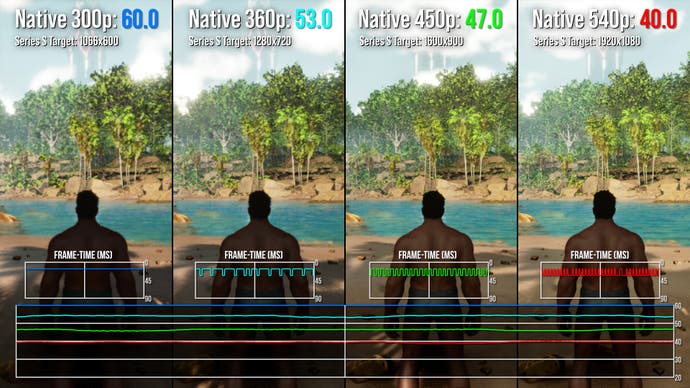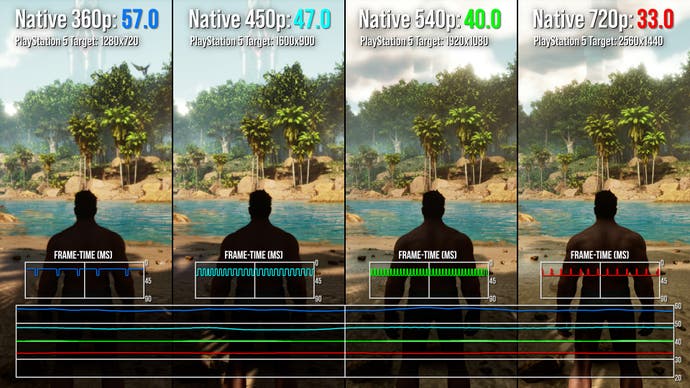Ark: Survival Ascended is the worst optimised Unreal Engine 5 game we've seen on console
Can customisable graphics options save the day?
We've seen some poorly optimised Unreal Engine games over the last few years, especially on console as developers try to implement new and impressive visual features within a limited performance budget. Ark: Survival Ascended, a UE5 remake of 2015's Ark: Survival Evolved, might just be the worst to date.
In remaking Survival Evolved, originally an Unreal Engine 4 game, over to the new UE5, developer Studio Wildcard opted to tap into as many new cutting-edge rendering features as possible while also shipping the game on Series X and Series S (via Game Pass) plus PS5 and PC. There are no last-gen versions, thankfully, but even on current-gen machines it's clear that the game provides a stern performance challenge.
After all, despite the original island from Survival Evolved arriving intact, the difference in fidelity is staggering, with UE5's Nanite used to chisel out fine geometric detail across the landscape, with rocks and foliage alike benefitting. There's also UE5's Lumen lighting, using a hybrid ray tracing technique to simulate global illumination and reflections on water. Beyond this, there are volumetric cloud systems in play, fog in woodland areas, dynamic water, improved physics, a better third-person camera and a lot more - a hugely feature-rich offering that at times looks spectacular.
For context, it's worth comparing the PC versions of Evolved and Ascended running at maximum settings. The nine-year-old Survival Evolved runs easily at native 4K on a powerful RTX 4080 machine, but Ascended struggles to reach 60fps even when running at an internal resolution of 1080p, upscaled to 4K by DLSS. The incredible demands of the game on PC do set the tone for the situation on console, machines with considerably less GPU and CPU resources available even on the top-tier PS5 and Xbox Series X - to say nothing of the weaker Series S.
Even running at lower settings than PC, which these console versions certainly do, it's clear that the developers were unwilling to sacrifice visual features to hit 60fps - and all three consoles are some way off of the target frame-rate. Waking up with your newly-made character, you'll be greeted with a choppy 25-50fps range of performance on Series X or PS5, and with v-sync disabled from the off, you get screen tear running up and down the frame too. It's quite a sight. For Series S, expect 20-45fps with screen tearing - and even lower - while the quality of Nanite and Lumen is dialled back significantly.
Before we get into the frame-rate testing then, it's worth taking a quick look at how these consoles and PC stack up. PS5 and Series X both target 1440p, but with dynamic resolution scaling almost always engaged the game is often rendering at its lower bound of 720p, a 50 percent scale. For Series S, the same logic applies, with a 900p target but most pixel counts resolving to an internal resolution of 450p (again 50 per cent scale). These low figures do fall in line with other UE5 titles that we've seen using Nanite and Lumen on console, such as Immortals of Aveum or Lords of the Fallen in its 60fps performance mode. Once again, PS5, Series X and Series S end up leaning heavily on low native resolutions and reconstruction tech to find the GPU headroom for UE5's best features.

Looking beyond the resolution, while PS5 and Series X seem to offer matched settings, Series S is cut back further in almost every option. Texture quality is lowered, as are shadows and ambient occlusion, resulting in a huge loss of detail underfoot. In the water, ripple physics are dialled back on Series S, while alpha transparencies for splashes are cut out too. You'll also notice screen space reflections (SSR) used across the water for Series S, where PS5 and Series X avoid occlusion artefacts around the player character by using Lumen. Lumen's impact on global illumination is also lessened on Series S, stripping out the colour bounce evident on PS5 and Series X.
On the plus side, draw distances for trees and major geometry are a match - a crucial point given the framework of the world must have a common ground for online play. But then, grass and rock density are pruned back on Series S, with more obvious pop-in for smaller details. Worse still, tree physics are disabled outright on Series S too, meaning we miss the swaying branches as we wade through thick jungle areas.
All round then, Series S is a heavily compromised take on this UE5 reimagining of Ark. Adding the PC version into the mix - using a mid-range Ryzen 7 5700X machine paired with a high-end RTX 4080 graphics card - is illuminating too. Series X and PS5 sit comfortably in the middle of PC and Series S, missing out on the top "epic" preset with a corresponding drop to rock and plant density plus a less welcome drop to texture quality. To their credit, Series X and PS5 do each push a respectable quality preset for Lumen, Nanite and volumetric fog.

Let's jump to performance testing next. Before we start, there's a unique feature in Ark: Survival Ascended - a command console that lets you tweak UE5 settings even on console. Connect a keyboard, hit the tilde key, and a universe of options open up. Given the dire state of the game's frame-rate on console by default, it's at least nice to see the developer give you tools to fix it yourself.
You're able to change the internal resolution, for example. Just enter r.setres in the command menu, and then your value. It's even possible to disable visual features like Lumen GI, reflections and volumetric clouds. In each case, find the command and enter 0 as the value at the end. Alas, all of your changes reset every time you reboot the game, so it's not an ideal fix. Still, if nothing else, the command console does solve one glaring problem on PS5, Series X and S: the screen tearing. Enter r.vysnc 1, and the tear lines are gone. And yes, it's possible to enable a 30fps cap too. Type t.maxfps 30, and we're locked at the 30fps line right away. The snag is that the frame-rate limiter does introduce unwanted judder, courtesy of uneven frame-pacing. With that in mind, let's see how each console fares in hitting 60fps on the game's default settings with v-sync enabled - and then how we might optimise the settings ourselves for better results.
Kicking off, we have Series S with its 900p target and 450p typical internal resolution. The game is fully unlocked to 60fps, though performance is normally about half that - or worse in dense jungle areas or the scorched earth map. In my playthrough I also found an area in North Zone 1 of the island that dropped frame-rates to as low as 13fps, especially when raining and at night. This hard drop appeared to fix itself after a console reset, but it's still something to look out for. Either way, the general trend on Series S is performance just above the 30fps line.
Fixing Series S is possible - and there are two approaches here. First, we can just drop the internal resolution until we hit 60fps more consistently, using the r.setres and r.secondaryscreenpercentage.gameviewport commands to lock to any specific target you like. The sobering reality though is that we need to drop Series S to a 600p target - often rendering at native 300p - to keep 60fps in view, and even then drops are possible during fast traversal.
The second approach to optimising for 60fps is a little more aggressive: sticking to the default 900p target - 450p internal - and instead dropping visual settings. Removing volumetric clouds gains 10fps, while additionally removing Series S' basic dynamic GI results in actually hitting that 60fps target... at the expense of a barren, lifeless world. Of course at this point, with so many features stripped out, the benefits of playing Survival Ascended over the 2015 original are limited. It's clear that the fundamental world design - the complexity of the island Studio Wildcard has built - just doesn't scale elegantly to Series S in any scenario. Only between a combination of resolution drops and disabled settings, is there a route to something close to 60fps, which might at least play reasonably well with a VRR display attached.
Switching over to Series X, we're at least closer to the 60fps mark, with a higher target resolution of 1440p - 720p internal. Frame-rates are generally in the 30-45fps range, but I did spot drops into the high 20s in some areas, like our Series S northern jungle stress point. Here, dropping the target resolution to 900p - 450p internal - provides a fairly good lock to 60fps. It's certainly a step down visually, but the performance improvement is also substantial. Just for fun, you could also set the resolution higher if you wanted - 1620p runs at 40fps, 1800p is at 36fps, and 4K results in a dip to 28fps. Much like Series S, we can also drop settings, with volumetric clouds and Lumen GI disappearing in exchange for a 60fps frame-rate readout. It works, but it's quite a visual sacrifice to make.



Finally we have PS5, and unfortunately the game looks to run worse overall on the Sony machine than on Series X in the opening beach area - at times up to 5-10fps lower despite matching settings. There's no clear cause for the performance delta, though later areas tend to put both on par. Sub-30fps drops area possible on each. In taxing jungle areas, PS5 runs at a similar 25-40fps range and with the odd traversal stutter - putting it far out of the ideal VRR range using default settings.
That means we have more of a task to find performance improvements, and here even running at 720p - 360p internal - doesn't provide a good enough 60fps lock. Rather, we're just shy of the mark at 58fps. Dropping to figures below that result in diminishing returns, too - and even glaringly low figures like 360p don't turn PS5's fortunes around. If we opt for visual settings tweaks instead, losing shadows (!), GI and volumetric clouds also results in performance just off 60fps. The game looks barren, but combined with a resolution drop, 60fps is just within reach on PS5.
It's impossible to call these optimised settings ideal in any way, but the state of Ark: Survival Ascended is dire enough to justify extreme measures. Right now, what we really need is a push from the developer itself to optimise the game for PS5, Series X and Series S using tools more advanced than what we have - the command console only takes us so far.
At a fundamental level, Ark: Survival Ascended did take me by surprise, at least, in how far it leverages Unreal Engine 5's features, ambitiously recreating Survival Evolved with Lumen, Nanite and volumetric fog. But when performance runs from 20-40fps with heavy screen tearing, it's clear that the game hasn't really been made with PS5, Series X or Series S optimisation in mind. It certainly exists on each platform, with varying degrees of cutbacks, but only really looks at its best on PC. Ultimately, if 60fps is the goal on console, Ascended is a game waiting for new and better hardware to arrive.










